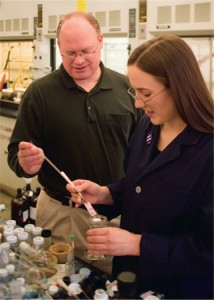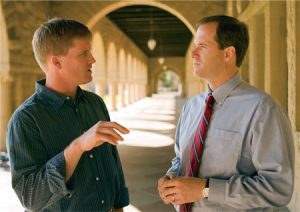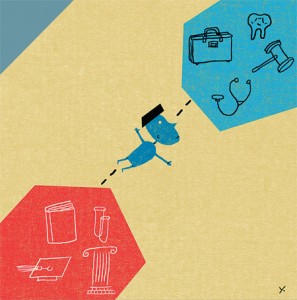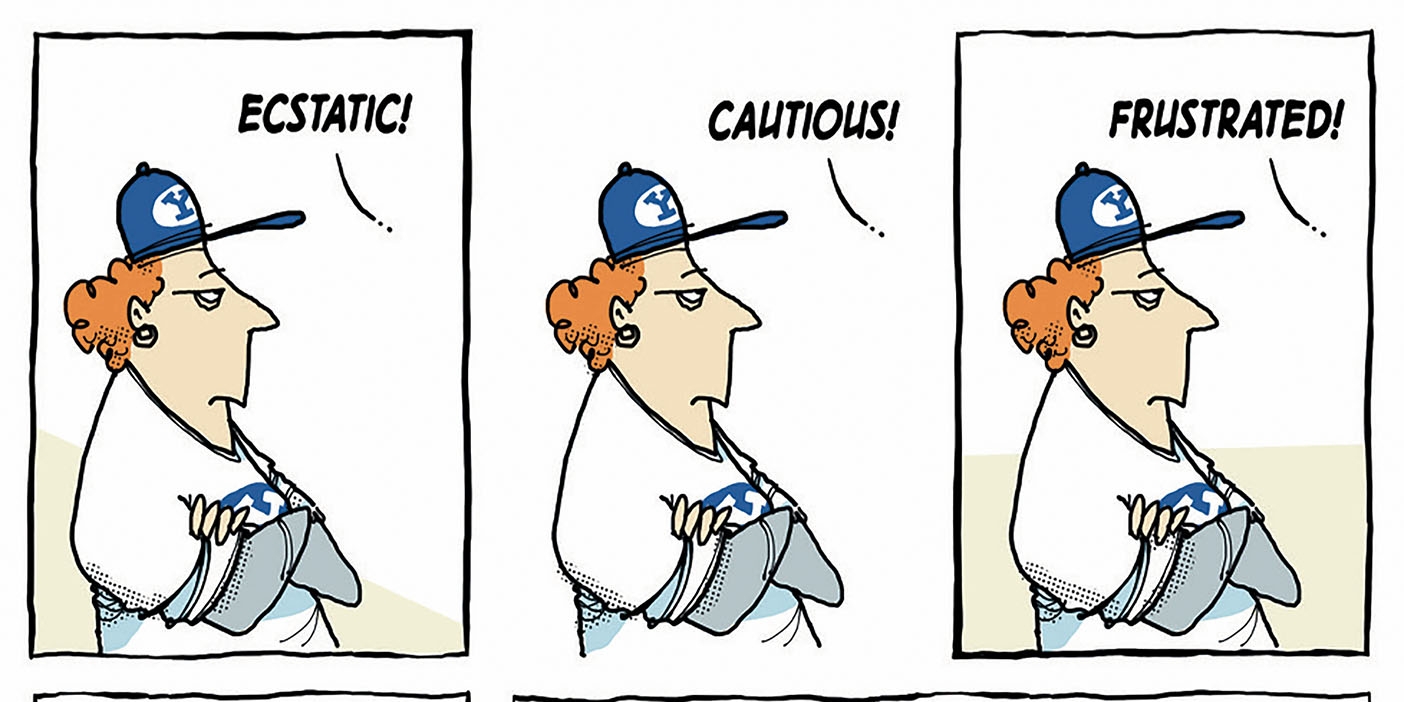The strength of BYU’s undergraduate program is propelling graduates into the upper reaches of academia.
 As a BYU junior in fall 2001, Jennifer Campbell learned from a blind date that biochemistry majors like herself could earn advanced elective credits by conducting research with a faculty member.
As a BYU junior in fall 2001, Jennifer Campbell learned from a blind date that biochemistry majors like herself could earn advanced elective credits by conducting research with a faculty member.
She recalled her positive experience a year earlier in Paul B. Savage’s (BS ’88) organic chemistry class and wandered by his office on the fourth floor of the Benson Building.
“I might want to work for you,” she announced.
“I might have something for you to do,” responded Savage, now associate chair of the Department of Chemistry and Biochemistry.
Campbell, now Jennifer O’Neill (BS ’03), volunteered that semester as what Savage calls an “apprentice” undergraduate laboratory researcher. At first, O’Neill recalls, she was intimidated by the complicated chemistry research and asked a lot of questions, even about things as relatively simple as what various chemicals did.
But with careful mentoring from Savage as well as from a postdoctoral researcher and a graduate student, O’Neill soon began contributing to the lab. After one apprentice semester, she began earning credit—and getting paid in the summers—to conduct research in the lab, where she stayed for two years.
The experience in Savage’s lab inspired O’Neill to seek a PhD in chemistry. She was accepted to the University of Wisconsin at Madison, and she is now in the fourth year of a five-year program there.
O’Neill is one of thousands of BYU graduates who have gone on to pursue the highest degree available in their chosen discipline, making BYU in recent years one of the top producers of eventual doctorate recipients.
For the decade of 1995 through 2004, BYU ranked 10th nationally in the number of alumni who earned research doctorates, according to a report based on the annual Survey of Doctorate Recipients, sponsored by the National Science Foundation and five other federal agencies and conducted by the National Opinion Research Center at the University of Chicago. BYU alumni earned 2,116 doctorates during that time, placing the university in the company of large and respected institutions such as UCLA, the University of Illinois at Urbana-Champaign, and Penn State.
This is hardly accidental. Along with BYU’s emphasis on a rigorous undergraduate experience, the school’s undergraduate mentoring program and its PhD-prep tracks have opened doors for students interested in graduate studies.
John S. Tanner (BA ’74), BYU’s academic vice president, says these efforts are core to BYU’s undergraduate emphasis. “BYU should be a wonderful incubator or launching pad for our students into the best programs,” he says.
Major, Minor, Mentor
When College of William and Mary assistant professor of law Nathan B. Oman (BA ’99) was a student at BYU, he developed a highly specialized career goal: he wanted to study political philosophy and one day become a legal scholar.
But Oman faced two obstacles. First, BYU did not have a specific course of study in political philosophy. Second, faculty in the political science and philosophy departments, where Oman studied for his respective major and minor requirements, did not generally have experience with legal academia.

Professor Paul B. Savage (BS ’88) helps senior Mary Katherine Taylor in a chemistry research laboratory. Hands-on laboratory experience gives BYU undergraduate students an edge in their graduate-school applications as well as in their eventual performance in advanced-degree programs.
Serendipitously, however, Oman connected with a political science professor who had both a PhD and a JD, and he advised Oman to conduct as much research and writing as possible before leaving BYU for law school. Without introduction, Oman walked over to the J. Reuben Clark Law School and knocked on the door of Professor W. Cole Durham, an accomplished scholar of international law and religion.
Although it is highly unusual for an undergraduate student to conduct legal research with a law professor, Durham and Oman coauthored an article. Oman also conducted research with several other BYU faculty, and he used BYU connections to land a position researching the archives of former Chief Justice Warren Burger.
“I think one of the greatest benefits I got out of my BYU education was I had so many opportunities to work on research with my professors,” Oman says. “That gave me a lot of experiences that a lot of other undergraduates would not have had.”
Like Oman, many BYU undergraduates who eventually pursue doctorates and enter academia do so in part because of BYU faculty mentoring. Although definitions of mentoring may differ, a common component is faculty involving undergraduate students in their own research and writing activities.
“They have to be involved in real research in something that is cutting edge,” says Savage, whose organic chemistry lab takes on as many as 10 undergraduate researchers at a time. “The only way students can learn what it means to be a research scientist is for them to get into a lab.”
Mentoring in the BYU Department of Chemistry and Biochemistry is largely responsible for placing students in top graduate programs at schools such as Wisconsin, Illinois, Michigan, Berkeley, and Cal-Tech, says Paul B. Farnsworth (BS ’77), department chair.
Each March hundreds of the college’s undergraduate students make 15-minute presentations of their work. During this process, the format for judging abstracts and making presentations mirrors that of academic conferences. Many of the students later present at domestic and international research meetings of academic organizations, allowing them to interact with scholars from around the world, Farnsworth says.
Like other faculty in the Department of Chemistry and Biochemistry, Savage traces his commitment to mentoring students to the mentoring he received as a BYU undergraduate. In Savage’s lab today, undergraduates participate along with postdoctoral fellows and graduate students in weekly research and literature meetings, where they are asked to summarize their chemistry work and their reading of scholarly journal articles. The undergraduates work somewhat independently in the lab, and some of them end up as coauthors on peer-reviewed research.
O’Neill, a native of Phoenix, spent 10 hours per week in Savage’s lab observing and assisting graduate students as well as fulfilling her own project assignments, focusing on the early steps of making anti-bacterial molecules and an anti-cancer drug. Savage himself came in regularly to work alongside the students, and the entire experience acculturated O’Neill to a chemistry lab setting. Plus, she says, she made great friends and had fun.
“We always had to listen to [Dr. Savage’s] music when he was in the lab,” O’Neill says. “He played Talking Heads.”
One Wisconsin faculty member, who has worked with O’Neill and other BYU graduates as research assistants, compared the BYU students’ preparation very favorably to that of students from other universities. Helen E. Blackwell, Wisconsin assistant professor of organic chemistry, estimated that the BYU graduates in Wisconsin’s graduate chemistry program are in the top 10 percent of their classes.
“They get a superb education at BYU, especially in chemistry,” Blackwell says. “In my experience, they have all been highly intelligent, well organized, honest, and motivated.”
A Running Start
When he left BYU in 1989 with dual bachelor’s degrees in economics and American studies to enroll at Yale Law School, current Stanford law professor Robert M. Daines wondered whether or not he could keep up.
“I figured that students who went to the Ivy League had gotten some secret sauce that we might have missed out on and I would be disadvantaged,” Daines recalls. “Within about six months I realized I was just as well prepared as any of my classmates who had gone to schools with fancier pedigrees.”
Daines’ experience is not unique. Many BYU graduates who move on to graduate programs elsewhere recall similar feelings of inadequacy at first, but their fears generally subside once they realize their graduate coursework is nothing they haven’t been adequately prepared for at BYU.
“I have yet to struggle to keep up as I have already been introduced to quite a bit of the material as an undergraduate,” says Nathan D. Trayner (BS ’06), one of four BYU graduates in his medical-school class at the University of Michigan.
Alan T. Sorensen (BA ’95), assistant professor of economics in Stanford University’s Graduate School of Business, says he benefited from the advice of several BYU economics faculty members, who guided him to take certain difficult courses that proved crucial during his first year as an MIT PhD student.

Alan T. Sorensen (BA ’95) and Robert M. Daines (BS ’89), both professors at Stanford, say rigorous undergraduate programs at BYU prepared them to perform well in challenging graduate and professional programs.
He says in graduate school “you feel like you’re getting a PhD in mathematics and not economics, and a lot of students wash out. BYU made a point of emphasizing the mathematics and preparing students for that.”
BYU’s Department of Economics, like other campus departments, prides itself on having a rigorous academic program. Although not all 150 annual BYU economics graduates go on to graduate school, they all have been through a challenging course of study, and those interested in pursuing PhDs generally have taken advanced theory courses in micro- and macroeconomics and have received a heavy dose of mathematics. Given the lack of a graduate economics program at BYU, undergraduates fill the research and teaching assistant roles that would normally be filled by graduate students. Those who later choose to seek doctorates, then, have a leg up on admissions and their own eventual research.
As a result, BYU economics students annually are admitted to the nation’s top PhD programs—not to mention business and law schools—and former BYU economics students teach on the faculties of universities such as Harvard, MIT, Stanford, Michigan, and Chicago.
“We just generally have very high standards for all of our students, and that’s helpful for any student, not just those going on to graduate school,” says Michael R. Ransom (BA ’77), Economics Department chair.
But rigor does not displace personal contact. Brigitte Condie Madrian (BA ’89), a BYU economics graduate who completed a PhD at MIT and now teaches at Harvard’s Kennedy School of Government, recalls a Harvard undergraduate who complained to her about having little or no contact with faculty due to large class sizes.
“That was the complete opposite of my experience at BYU,” says Madrian, who worked as a research and teaching assistant for several BYU faculty. “I had lots of classes with 10, 15, or 20 students, and by the time I graduated, I felt like I knew almost every single faculty member in the department and they knew me.”
Tracks to Success
As a Marriott School master’s of accountancy student planning to practice accounting after graduation, Stephen R. Stubben (BS, MAcc ’02) had no reason to think about earning a PhD. But one day after an oral examination, Marriott School associate professor Scott L. Summers (BS ’90) suggested that, based on Stubben’s skills and interests, he should consider pursuing an academic career. The Cleveland, Ohio, native did not give the suggestion much thought at first.
Soon, however, Stubben learned that the School of Accountancy had been developing a formal PhD-preparation program for MAcc students. After a persuasive meeting with Douglas F. Prawitt (BS ’88), prep-track coordinator, Stubben became a member of the first group of formal accounting PhD-prep-track students at BYU in 2000. Stubben went on to complete a PhD at Stanford University and now teaches at the University of North Carolina’s business school.
Since its inception, the BYU accounting PhD prep track has become one of the nation’s top suppliers of accounting PhD students and, by extension, accounting faculty. The program has been successfully duplicated for BYU master’s of information systems students preparing to enter PhD programs.
 Prep-track students get the best of both worlds because they are exposed to practice and scholarship. They participate in academic-research seminars; engage in collaborative research projects with faculty; and enroll in elective courses in areas such as mathematics, economics, econometrics, and statistics.
Prep-track students get the best of both worlds because they are exposed to practice and scholarship. They participate in academic-research seminars; engage in collaborative research projects with faculty; and enroll in elective courses in areas such as mathematics, economics, econometrics, and statistics.
“They are highly sought after because they are the only students who are specifically prepared to go into a PhD program,” says Prawitt, now the Glen Ardis Professor of Accounting at BYU. “There’s no other program like this one.”
Robert Libby, a professor of management at Cornell University’s Johnson Graduate School of Management, which has regularly admitted BYU graduates in recent years for accounting PhD studies, says BYU’s prep-track programs reduce the chance of PhD students dropping out.
“I think the biggest thing is they have a much better understanding of what’s involved in a PhD program and in academia,” Libby says. “The other thing is that since BYU has a research-active faculty but no PhD program, [students] often get to work as research assistants even beyond the course work.”
Master’s of information systems students in the prep track have a 100 percent placement rate in top PhD schools in recent years, says Paul Benjamin Lowry (BS ’91), assistant professor and coordinator of the information systems PhD prep track. A high percentage of those students also received tuition waivers, travel money, health insurance, and yearly stipends.
“The program has made it much safer and easier for students to consider getting a PhD,” says Darren T. Roulstone (BS, MAcc ’95), a BYU MAcc graduate who is now associate professor of accounting at the University of Chicago Graduate School of Business. “Before, you had to really believe it was for you even with incomplete information because there wasn’t a lot of help learning about it.”
Building on Natural Capacity
Vice President Tanner and other administrators are the first to admit that BYU’s success in preparing eventual doctorate recipients cannot be solely attributed to the university’s mentoring efforts and rigorous academic programs. They give much of the credit to the students themselves, their families, and the educators who worked with them before they arrived at BYU. “Our students are the kind who are hard working and want to go on and improve themselves,” says Tanner.
David A. Kaiser (BS ’84), associate clinical professor and health professions advisor, agrees: “We’re dealing with such great, bright students who get admitted to BYU in the first place that I think it’s a natural progression that a significant number will go on to graduate schools and professional schools. They have that capacity and maybe some predisposition before they get here.”
But even bright students need the direction, training, and growth opportunities that faculty can provide. For her part, O’Neill will always credit the BYU faculty and programs that inspired and guided her toward advanced degree studies and will continue to guide her as she moves into her career. She hopes to someday teach undergraduate chemistry and pass on the passion for chemistry she witnessed and personal attention she received on those long afternoons listening to “Talking Heads” in the Savage lab.
If emulation is the sincerest form of flattery, then O’Neill pays Savage and other faculty a heartfelt compliment.
GOING PROFESSIONAL
While BYU is in the top 10 among universities whose graduates eventually earn PhDs and other research doctorates, available numbers and anecdotal evidence suggest BYU is also among the nation’s top suppliers of students for professional-degree programs in law, medicine, and dentistry.
In a given year as many as 350 BYU students apply to medical schools, and nearly 300 apply to dental schools, says David A. Kaiser (BS ’04), associate clinical professor and health professions advisor. More than half of BYU students who apply to medical programs are accepted, and BYU comes in at number six nationwide for the number of graduates accepted to medical school. With roughly two-thirds of BYU’s dental-school applicants accepted, BYU produces the most dental-school-bound students in the country.
About three-fourths of BYU’s 800 annual law school applicants are accepted, making BYU one of the largest suppliers of the nation’s approximately 48,000 entering law students each year, says Catherine Newell Bramble (BA ’02), BYU preprofessional director. Among its undergraduates, BYU has the sixth-largest number of law school applicants in the country.
Each year hundreds of BYU pre-law students seek admission to BYU and the University of Utah, but BYU graduates have attended virtually all 192 American Bar Association–accredited law schools, Bramble says. Meanwhile, with no dental school in Utah, BYU graduates interested in that field have congregated in particular at schools like Creighton University in Omaha, Neb., and Case Western Reserve University School of Dentistry in Cleveland, Ohio.
At Case Western, 10 out of 70 entering dental students in 2006 were BYU graduates, says David A. Dalsky, director of admissions at Case Western School of Dentistry. Case Western dental student Bryce W. White (BA ’05) says BYU’s advisement process for dental admissions is highly refined.
“They do it so much they really know the system,” White says. “I wasn’t the first dental student to ever apply out of BYU. I knew exactly what I needed to achieve to be accepted into dental school.”
At Creighton BYU alumni have created what might be called “Little Provo”—a collection of nearly 200 townhouses in the Village Green complex that consists of about 80 Latter-day Saint family occupants, many of whom are BYU graduates in dental, medical, law, physical-therapy, and other graduate programs, says Chase O. Dansie (BA ’04), a third-year Creighton dental student.
“It is nice to be close for study groups, church activities, and to borrow a cup of sugar every once in a while,” Dansie says.
The BYU Preprofessional Advisement Center also assists students interested in pursuing professional business degrees such as the MBA, MOB, or MPA. Approximately one-fourth of Marriott School of Management undergraduates eventually pursue graduate business degrees, says R. Jay Irvine, Marriott School placement coordinator.
Whatever the field, Bramble believes students entering professional programs, like those who pursue research doctorates, will find that the hard work and resources expended pay off.
“I don’t think they will ever regret it,” she says. “In this increasingly competitive market, a bachelor’s degree is not worth as much as it used to be.”
Ed Carter is a BYU assistant professor of communications.
Feedback: magazine@byu.edu
web: Learn more about the Preprofessional Advisement Center’s services for students interested in management, law, or health professions at ccc.byu.edu or by calling 801-422-3044.









